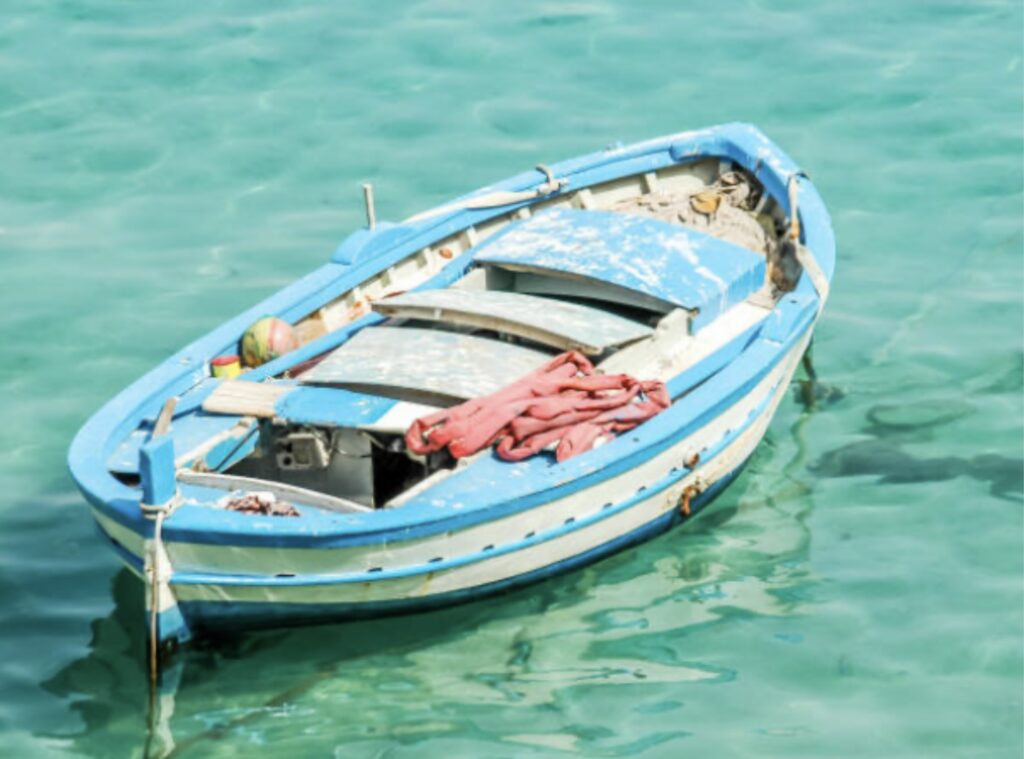Welcome to the A-Z of featured Green Travel Destinations – with tips on where to visit, stay, what to experience and how to travel sustainably.
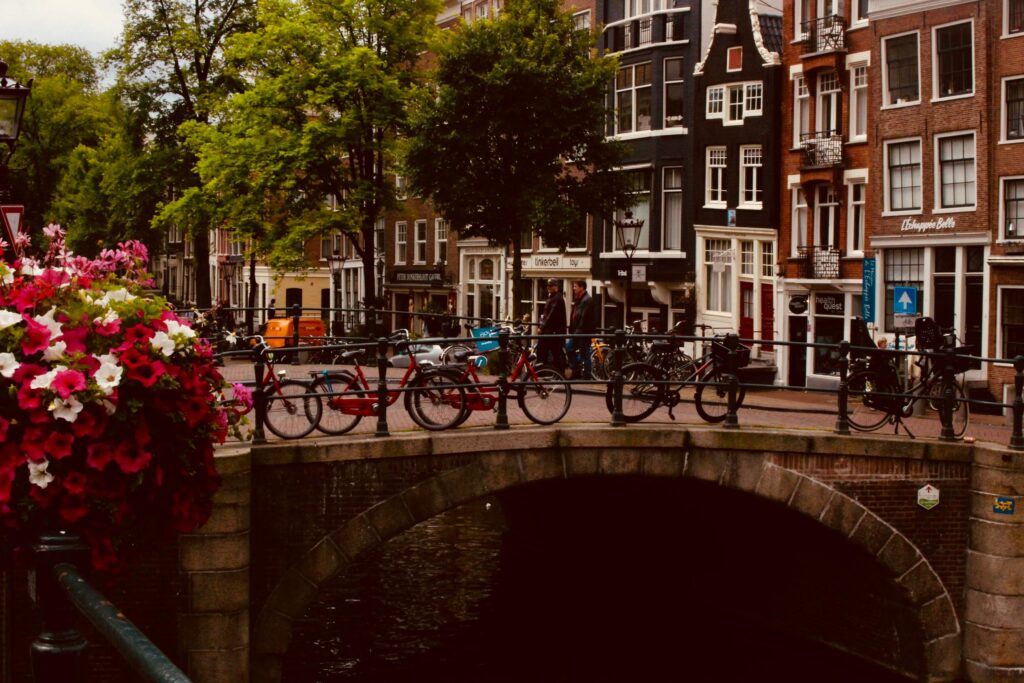

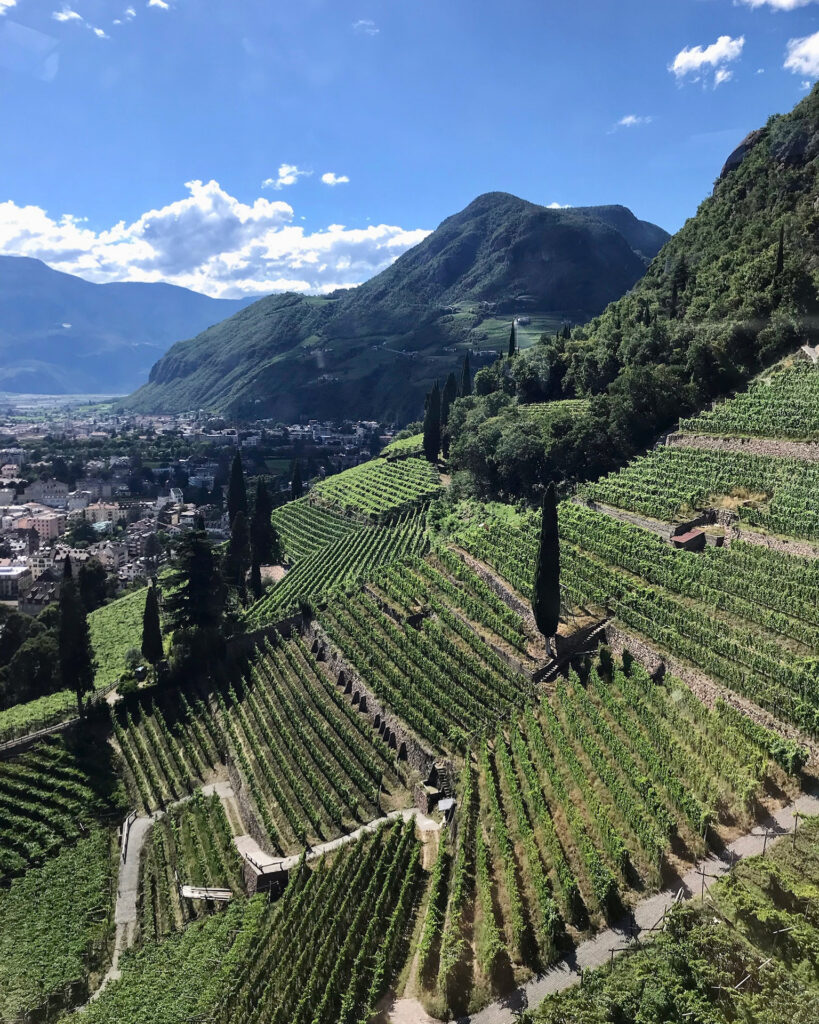
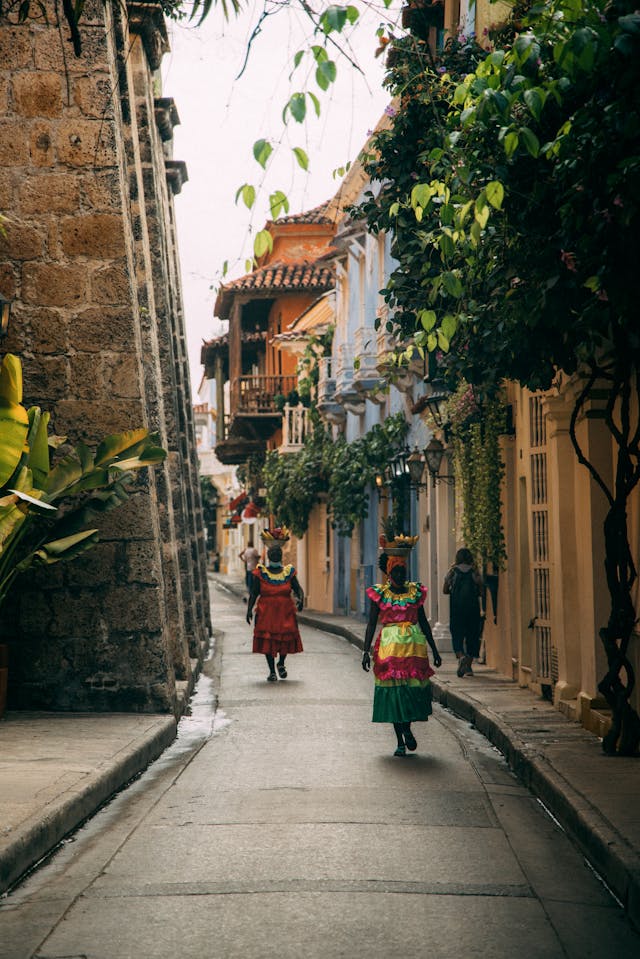
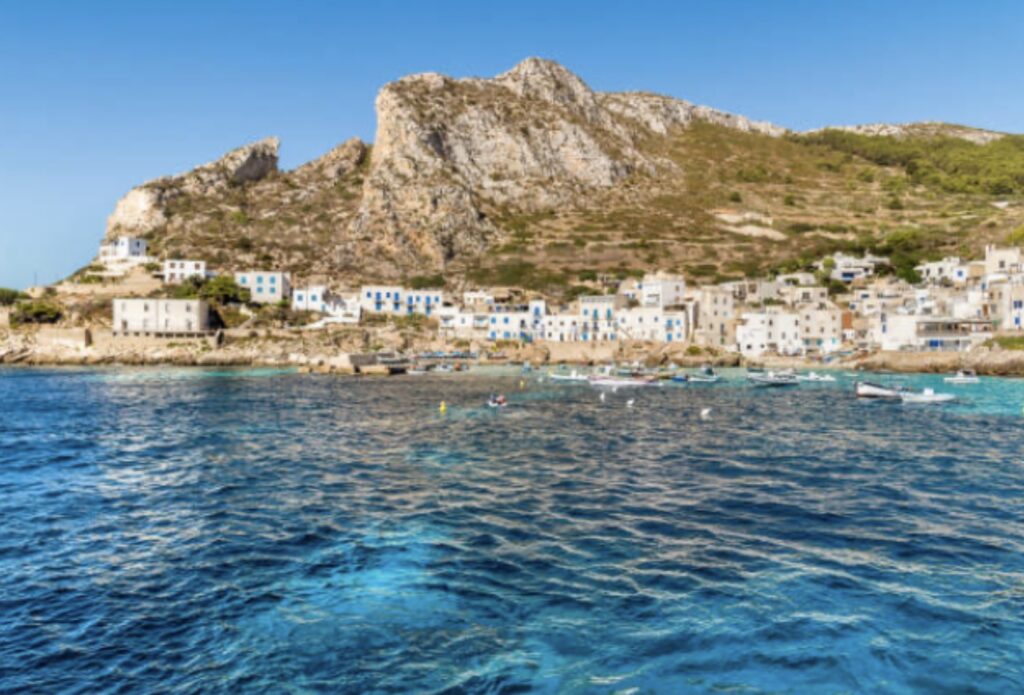
A: Amsterdam
Green Travel Guide to Amsterdam

Amsterdam, known for its iconic canals, vibrant culture, and rich history, has become a leading city in Europe for sustainable tourism. With its commitment to green initiatives, eco-friendly accommodations, and a thriving bike culture, Amsterdam is a perfect destination for travellers who want to experience the city while minimising their environmental impact. Whether you’re wandering through its picturesque neighbourhoods, enjoying local cuisine, or exploring its world-class museums, you can do so with a conscious mind and a greener footprint.
This Green Travel Destination Guide to Amsterdam highlights the city’s sustainable attractions, eco-conscious accommodations, and tips for reducing your environmental impact while having an unforgettable experience.
Getting to Amsterdam: Sustainable Travel Options
By Train: Traveling to Amsterdam by train from neighbouring European countries is an excellent green option. The Eurostar from London or the Thalys from Paris offers a low-carbon alternative to flying and takes you directly to Amsterdam’s central station.
By Bike: For eco-conscious travellers already within Europe, consider traveling to Amsterdam by bike or through cycling tours, which allows you to arrive sustainably while soaking in the landscape along the way.
By Plane: If flying is necessary, consider offsetting your carbon emissions with airlines that offer carbon offset programs or use platforms like MyClimate or Gold Standard to offset the impact of your flight.
Sustainable Transportation Within Amsterdam
Amsterdam is a paradise for green travel enthusiasts due to its emphasis on cycling, sustainable public transport, and clean air policies.
Biking: The bike is the most eco-friendly way to navigate the city. With more bikes than residents, Amsterdam’s bike lanes are extensive and safe, making it easy for visitors to rent a bike and explore neighbourhoods, parks, and scenic routes. Many bike rental companies, such as Yellow Bike or MacBike, offer bikes for rent with environmentally friendly practices.
Public Transportation: The city operates an excellent public transport system with buses, trams, and metro trains. The GVB (Amsterdam’s public transport company) runs electric trams and buses, making it a low-carbon alternative to taxis or private car hire. Purchase a multi-day travel pass for unlimited access to public transport.
Electric Boats: Amsterdam is renowned for its canals, and you can explore them by renting an electric boat. Companies like Boaty and Amsterdam Electric Boat offer eco-friendly boat tours and rentals, allowing you to explore the city’s waterways without the pollution of traditional motorised boats.
Walking: Amsterdam’s compact size makes it an excellent walking city. Stroll through neighbourhoods like Jordaan or De Pijp, visit museums, or relax in its many parks, all while reducing your carbon footprint.
Eco-Friendly Accommodations
Amsterdam offers a variety of sustainable accommodations for travellers looking to reduce their environmental impact. Here are some top eco-friendly options:
Conscious Hotel: With several locations throughout the city, Conscious Hotel is one of Amsterdam’s leading sustainable hotel chains. The hotel uses 100% renewable energy, offers organic breakfast options, and is committed to waste reduction, including plastic-free initiatives.
The Student Hotel Amsterdam City: A modern, environmentally conscious hotel that provides sustainable amenities such as energy-efficient heating and cooling, low-water usage systems, and a bike-friendly atmosphere for guests.
Green Key Certified Hotels: Many Amsterdam hotels are certified by the Green Key, an international eco-label that recognises hotels for their environmental responsibility. These hotels focus on sustainable practices such as water and energy conservation, waste reduction, and using environmentally friendly products. Examples include Hotel Jakarta and Zoku Amsterdam.
Sustainable Attractions and Activities
Amsterdam offers a wide range of activities and attractions that cater to green travellers, from cultural experiences to outdoor adventures. Here are a few must-see places and activities that prioritise sustainability:
1. Vondelpark
Vondelpark is Amsterdam’s most famous park and a beautiful spot for walking, cycling, or simply relaxing. The park spans over 120 acres, and visitors can enjoy its biodiversity while supporting sustainability by arriving by bike or on foot.
Eco-tip: Pack a picnic with locally sourced ingredients or grab food from one of the park’s eco-conscious cafés.
2. Amsterdam’s Canal Cruises (Eco-friendly Options)
While traditional boat tours might contribute to pollution, several companies in Amsterdam now offer electric canal cruises. These eco-friendly tours allow you to explore the city’s iconic canals in a way that’s gentle on the environment.
Eco-tour Operators: Consider Green Boat Amsterdam or Boaty, both of which offer electric boats for private tours. These companies reduce the environmental impact and allow you to enjoy the scenery without the noise and pollution of diesel-powered vessels.
3. Rijksmuseum
The Rijksmuseum is one of the most iconic cultural institutions in Amsterdam, and it’s also working towards sustainability. The museum has an ongoing commitment to reducing its energy usage and carbon footprint, and they encourage visitors to use public transport or bike to the museum.
Eco-tip: Buy your tickets online to avoid the need for printed paper and help reduce waste.
4. Hortus Botanicus
The Hortus Botanicus, one of the oldest botanical gardens in the world, is a peaceful and green escape in the heart of Amsterdam. The garden showcases diverse plant species from around the globe, including many endangered ones, and serves as a center for conservation and education about biodiversity.
Eco-tip: Visit the garden’s café, which serves locally sourced, organic food.
5. Urban Farms and Markets
Amsterdam’s dedication to sustainability is also visible in its local food scene. The city is home to many urban farms and organic markets where visitors can learn about sustainable farming practices and support local producers.
Farmers Markets: The Noordermarkt and Boerenmarkt are both excellent places to shop for locally grown, organic produce. Many markets also feature sustainable food stands and zero-waste vendors.
Eco-Friendly Dining and Shopping
Amsterdam is home to many restaurants and cafes that serve locally sourced, organic, and sustainable food. Here are some places to dine and shop sustainably:
1. Vegan Junk Food Bar
For those looking for a plant-based dining experience, Vegan Junk Food Bar offers delicious, eco-friendly options. Vegan cuisine has a significantly lower carbon footprint compared to meat-based dishes, making it a great choice for sustainability.
2. The Avocado Show
This restaurant is dedicated to showcasing the versatility of avocados (no really!), and it focuses on serving locally sourced, seasonal produce. It also works with sustainable suppliers to ensure a low environmental impact.
3. De Hallen
De Hallen is a repurposed industrial complex turned into a sustainable hub for dining, shopping, and culture. It features local artisan shops, sustainable fashion boutiques, and eco-conscious food vendors, allowing visitors to experience green shopping in a historic setting.
4. Sustainable Shopping at the NDSM Wharf
The NDSM Wharf is a creative community and artistic district located along the IJ River. Here, you can find eco-friendly, sustainable shops selling everything from recycled art to second-hand clothing and handmade crafts. The area is a hub for Amsterdam’s sustainable, creative economy.
Green Travel Tips for Amsterdam
- Offset Your Carbon Emissions: If you must fly to Amsterdam, consider offsetting your carbon emissions with programs like CO2Logic or MyClimate.
- Support Local and Ethical Businesses: Always look for businesses that follow sustainable practices, such as using organic, fair-trade products or engaging in waste-reduction initiatives.
- Stay Hydrated Sustainably: Amsterdam has clean drinking water, so carry a refillable bottle to avoid single-use plastics.
- Respect Nature: Whether you’re walking through parks or visiting nature reserves, remember to leave no trace, dispose of waste responsibly, and stay on marked paths.
Amsterdam as a Green Destination
Amsterdam has earned its reputation as a leader in sustainable urban living, and its commitment to green travel makes it an ideal destination for eco-conscious travellers. By embracing bike culture, supporting local businesses, and choosing eco-friendly accommodations and activities, visitors can explore this historic city while minimising their environmental impact. Whether you’re enjoying the canals, sampling local cuisine, or immersing yourself in the arts, Amsterdam offers plenty of opportunities for green travel and responsible tourism.
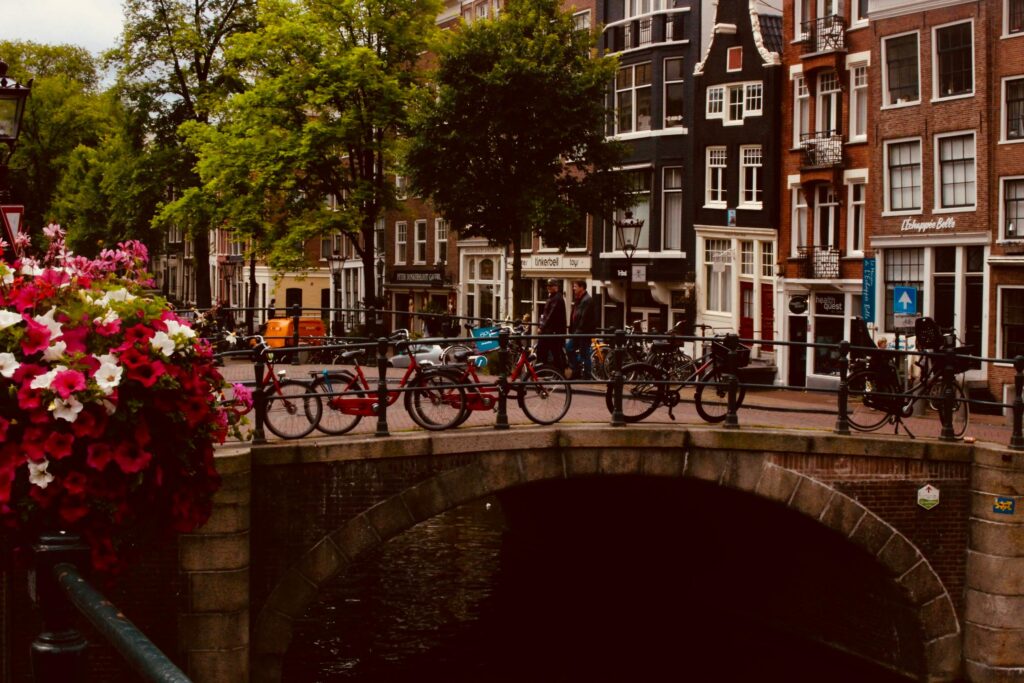
B: Buenos Aires, Argentina
Green Travel Guide to Buenos Aires

Buenos Aires, Argentina’s bustling capital, offers travellers a vibrant mix of culture, history, and modernity. Known for its dynamic neighbourhoods, its bookshops, tango, and world-class cuisine, Buenos Aires has also made strides in becoming a more sustainable city. Whether you’re visiting the city’s historical landmarks, exploring its green spaces, or indulging in its culinary delights, Buenos Aires offers numerous opportunities to travel sustainably while enjoying its beauty and charm.
This Green Travel Destination Guide to Buenos Aires will highlight the city’s eco-friendly attractions, green accommodations, and tips for reducing your environmental impact while discovering the best of Argentina’s cultural hub.
Getting to Buenos Aires: Sustainable Travel Options
By Plane: For international travellers, Buenos Aires is accessible via Ezeiza International Airport (EZE). While flying is often necessary, consider offsetting your carbon emissions through platforms like MyClimate or CO2logic, which allow you to neutralise the impact of your flight.
By Train: For travellers within South America, taking the train from nearby cities like Montevideo (Uruguay) or Rosario can be a more sustainable option. Train travel offers a lower carbon footprint compared to flying, and it provides a chance to see more of the countryside on the way to Buenos Aires.
Sustainable Transportation Within Buenos Aires
Buenos Aires offers several sustainable transportation options that make it easy to get around while minimising your environmental impact.
Biking: The city is becoming increasingly bike-friendly, with a network of bike lanes and a bike-share system called Ecobici. Rent a bike and explore the city’s historic neighbourhoods, parks, and riverside areas on two wheels.
Public Transportation: Buenos Aires boasts a comprehensive public transport system with buses, trams, and the Subte (subway). The city has made efforts to modernise its public transport infrastructure to reduce emissions, including the introduction of electric buses and a fleet of eco-friendly Subte trains. Consider purchasing a SUBE card for unlimited travel on public transit, which is both budget-friendly and efficient.
Electric Scooters and Car Sharing: Electric scooters are available for rent via apps like Grin and Turo, providing a quick and eco-friendly way to get around the city. Alternatively, car-sharing services like TuCar offer electric vehicles, allowing you to rent a car without the environmental impact of traditional car rentals.
Walking: Buenos Aires is a pedestrian-friendly city, especially in areas like Palermo, Recoleta, and San Telmo. Walking is a fantastic way to explore the city’s diverse neighbourhoods, uncover hidden places, and reduce your carbon footprint.
Eco-Friendly Accommodations in Buenos Aires
Buenos Aires offers a variety of green accommodations for those looking to reduce their environmental impact while enjoying the city. Here are some options to consider:
Vain Boutique Hotel: Located in the Palermo neighbourhood, Vain Boutique Hotel is known for its eco-conscious approach to hospitality. The hotel offers sustainable amenities, such as water-saving fixtures, energy-efficient lighting, and the use of eco-friendly cleaning products.
Mine Hotel Boutique: Also in Palermo, this boutique hotel is committed to sustainability through water and energy conservation, waste reduction, and the use of organic and locally sourced products in its amenities and food offerings.
Urban Suites Recoleta Boutique Hotel: A modern, eco-friendly hotel located in Recoleta, this property prioritises sustainability with energy-saving measures, waste management, and eco-conscious building materials.
The Green House Hostel: A more budget-friendly, eco-conscious option, The Green House Hostel in San Telmo offers a welcoming atmosphere with a focus on sustainability, including eco-friendly facilities, waste recycling programs, and community-based initiatives.
Sustainable Attractions and Activities
Buenos Aires is full of green spaces, cultural landmarks, and eco-conscious initiatives. Here are some activities that let you experience the city while supporting sustainability:
1. Parque Tres de Febrero (Bosques de Palermo)
One of the largest green spaces in Buenos Aires, Parque Tres de Febrero offers lush gardens, lakes, and walking paths perfect for a leisurely day in nature. The park is home to the Rosedal (Rose Garden), where visitors can enjoy a peaceful retreat from the urban hustle.
Eco-tip: Bring a reusable water bottle and a picnic with locally sourced ingredients to minimise waste and support local food systems.
2. Ecological Reserve Costanera Sur
The Ecological Reserve Costanera Sur is a must-visit for nature lovers. Located along the Río de la Plata, the reserve is a haven for wildlife, including birds and native plant species. It’s a popular spot for walking, cycling, and birdwatching while providing an opportunity to connect with the natural environment in the heart of the city.
Eco-tourism: Participate in a guided eco-tour to learn more about the reserve’s biodiversity and conservation efforts.
3. El Zanjón de Granados
For a historical and sustainable experience, visit El Zanjón de Granados, an underground museum that takes you through the early days of Buenos Aires. The museum uses sustainable practices, including energy-efficient lighting, and promotes the preservation of the city’s historical heritage.
Eco-tip: Opt for a walking tour of the neighbourhood to reduce your carbon footprint while learning about Buenos Aires’ rich history.
4. Feria de Mataderos
The Feria de Mataderos is an eco-friendly artisan market held in the Mataderos neighbourhood, where you can buy locally made crafts, organic foods, and traditional Argentine goods. The fair also emphasises sustainable practices and the support of small-scale farmers and artisans.
Eco-tip: Shop for unique, handmade items that are produced sustainably and support local artisans directly.
5. Buenos Aires Street Art Tour
Buenos Aires is home to some of the world’s most impressive street art, and a guided street art tour in neighbourhoods like La Boca, San Telmo, and Palermo lets you explore the city’s urban culture in an eco-conscious way. The city’s public art is often created with recycled materials and messages of environmental and social activism.
Eco-tip: Choose a local tour operator that emphasises sustainability and community engagement in their programs.
Eco-Friendly Dining and Shopping
Buenos Aires is a haven for food lovers, and sustainable dining options are on the rise. Here are some green places to eat and shop:
1. Hierbabuena
Located in the San Telmo district, Hierbabuena is a vegetarian and organic restaurant offering delicious, locally sourced, and seasonal dishes. The restaurant uses organic ingredients and works with local farmers to promote sustainable agriculture.
2. La Verde
A sustainable café in the Palermo neighbourhood, La Verde focuses on healthy, organic, and plant-based food. They offer a variety of eco-conscious products, including locally grown produce, vegan options, and coffee from ethical suppliers.
3. Mercado de San Telmo
The Mercado de San Telmo is a historic market that showcases local products and organic goods. Here, you can shop for fresh produce, artisanal cheeses, meats, and crafts, while supporting small-scale farmers and vendors.
4. El Club de la Milanesa
A classic Argentine dish gets a sustainable twist at El Club de la Milanesa, a restaurant that focuses on using local, organic ingredients and minimising food waste. They have a commitment to sustainable sourcing, including ethical meat options and plant-based alternatives.
Green Travel Tips for Buenos Aires
- Offset Your Carbon Emissions: Consider offsetting your carbon emissions through programs like MyClimate or ClimateCare, especially if you’re flying into Buenos Aires.
- Support Locally Owned Businesses: Choose restaurants, shops, and accommodations that focus on local, sustainable sourcing and eco-friendly practices.
- Use Public Transport and Bicycles: Take advantage of the city’s excellent public transportation system and bike-sharing programs to reduce your environmental footprint.
- Minimise Waste: Carry a reusable bottle, bring your own bags for shopping, and avoid single-use plastics wherever possible.
Buenos Aires as a Green Destination
Buenos Aires offers a unique combination of vibrant culture and sustainable practices, making it an ideal destination for eco-conscious travellers. With its thriving public transport system, green spaces, and focus on sustainable food and tourism initiatives, Buenos Aires proves that large urban centres can embrace green travel. By choosing eco-friendly accommodations, supporting local businesses, and participating in responsible tourism activities, you can explore this dynamic city in a way that minimises your environmental impact while enjoying everything it has to offer. Whether you’re cycling through the streets or exploring the city’s natural reserves, Buenos Aires is a place where sustainability and culture go hand in hand.

C: Cartagena, Colombia
Green Travel Guide to Cartagena
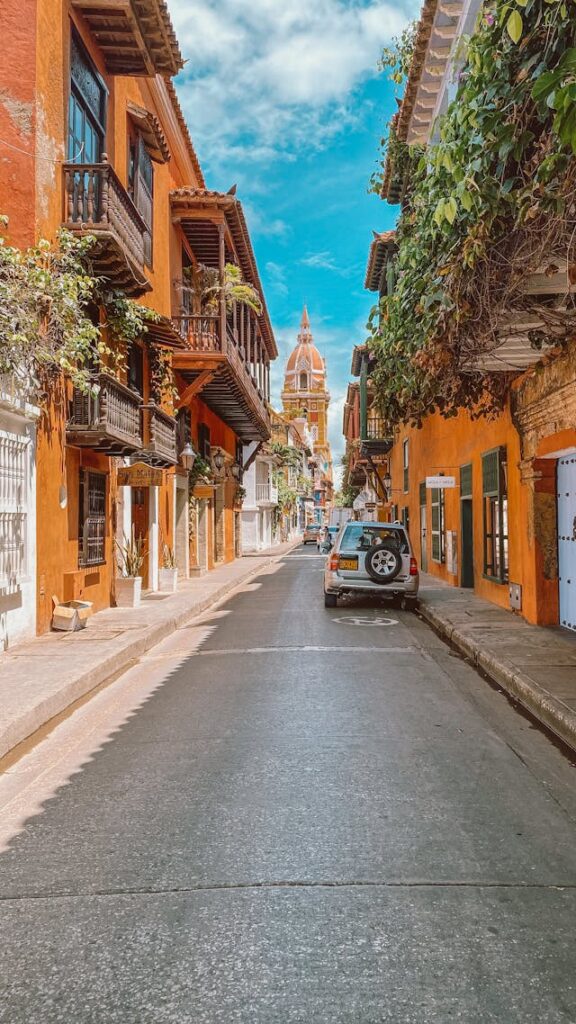
Cartagena, Colombia’s stunning coastal city, is a blend of picturesque colonial architecture, lush landscapes, and rich history. Located on the Caribbean coast, Cartagena is a UNESCO World Heritage Site known for its stunning beaches, colourful streets, and historical significance. As the city grows in popularity, Cartagena has made strides toward embracing sustainability and eco-conscious tourism. Travellers looking to explore this cultural city with a green travel mindset will find plenty of eco-friendly options, from accommodations to transportation and eco-conscious activities.
This Green Travel Destination Guide to Cartagena will highlight the city’s sustainable attractions, green accommodations, and tips on how to minimise your environmental impact while enjoying the best of Cartagena.
Getting to Cartagena: Sustainable Travel Options
By Plane: Cartagena is served by Rafael Núñez International Airport (CTG), which connects to major cities within Colombia and internationally. Although flying may be necessary, consider offsetting your carbon emissions through programs like MyClimate or CO2logic to help mitigate the environmental impact of your flight.
By Bus: For travelers already in Colombia, taking a long-distance bus from nearby cities like Barranquilla or Santa Marta is a more sustainable option. The bus network is extensive and offers a low-carbon alternative to flying.
Sustainable Transportation Within Cartagena
Cartagena has developed several eco-friendly transportation options for visitors, making it easier to explore the city with a minimal environmental footprint.
Walking: Cartagena’s historical center, including the Old City and Getsemaní, is best explored on foot. The narrow, cobblestone streets are pedestrian-friendly, and walking allows you to immerse yourself in the local culture and architecture while minimising your carbon footprint.
Biking: Cartagena is also becoming increasingly bike-friendly. You can rent bikes through local providers like Bike Tours Cartagena, which offers sustainable bike tours of the city. The Cartagena Bike Path has made cycling a more accessible option, especially for those looking to explore the city in an eco-conscious way.
Electric Cars and Taxis: While Cartagena’s city center is relatively compact, there are options for renting electric cars or using electric taxis. This mode of transportation helps reduce the carbon emissions typically associated with city travel.
Public Transportation: Cartagena has a growing bus network, and some buses are now operating with cleaner, more efficient energy options, such as natural gas. For short distances, tuk-tuks are a common, eco-friendly alternative for navigating the city.
Eco-Friendly Accommodations in Cartagena
For green travellers looking to stay in sustainable accommodations, Cartagena offers several eco-conscious hotels and hostels. Here are some top options for your stay:
Casa San Agustin: A luxurious yet sustainable hotel located in the heart of Cartagena’s historical center, Casa San Agustin uses energy-efficient systems, recycles water, and supports local artisans by showcasing their work. The hotel’s commitment to preserving local culture and the environment makes it an ideal eco-friendly choice.
Hotel Charleston Santa Teresa: This 5-star hotel embraces sustainability through the use of renewable energy sources, energy-saving devices, and waste reduction strategies. The hotel also uses locally sourced materials in its design, helping to minimise its carbon footprint.
El Marqués Boutique Hotel: Set in a colonial-style house, this boutique hotel offers sustainable amenities, such as eco-friendly toiletries, water-saving fixtures, and locally sourced food options.
Cartagena Green Hostel: For budget-conscious travellers, Cartagena Green Hostel is a great option. The hostel uses sustainable practices like energy-efficient lighting, water-saving systems, and promotes environmental education among its guests.
Sustainable Attractions and Activities
From historical sites to natural reserves, Cartagena is full of eco-conscious attractions that let you experience the best of the city while keeping sustainability in mind.
1. Castillo de San Felipe de Barajas
The Castillo de San Felipe de Barajas is one of Cartagena’s most iconic historical landmarks. Built during the colonial era, this fortress is a UNESCO World Heritage Site and offers panoramic views of the city. It’s a must-see for history buffs, and its preservation efforts are aligned with sustainability initiatives that help maintain the city’s historical integrity.
Eco-tip: Explore the castle on foot to avoid using transportation and engage in educational tours that focus on the conservation of the site.
2. Rosario Islands (Islas del Rosario)
Just a short boat ride from Cartagena, the Rosario Islands are a beautiful archipelago renowned for their white sandy beaches, crystal-clear waters, and marine biodiversity. Many tour operators are now offering eco-friendly boat trips that prioritise minimising their impact on the environment and protecting the coral reefs and marine life.
Eco-tip: Choose operators who use electric or low-emission boats and always bring your own reusable water bottle to avoid single-use plastics.
3. La Boquilla Mangrove Tour
For an eco-conscious adventure, take a guided tour through the La Boquilla mangroves, a protected natural area located just outside Cartagena. This eco-tour allows visitors to explore the region’s biodiversity and learn about conservation efforts that help protect this vital ecosystem. Kayaking through the mangroves is an excellent way to enjoy the area sustainably.
Eco-tip: Choose a certified eco-tour operator who follows responsible tourism practices and educates visitors about conservation.
4. Getsemaní Neighborhood
The vibrant Getsemaní neighborhood is not only a hub for street art and nightlife but also an area with a strong community engagement focus. Visitors can explore local art initiatives, community-led projects, and sustainable urban development efforts. Many local businesses and artists are dedicated to promoting eco-consciousness and sustainability in the neighbourhood.
Eco-tip: Support local businesses, including cafes, galleries, and shops, that prioritise sustainability, such as using eco-friendly products and supporting fair trade.
5. San Basilio de Palenque
San Basilio de Palenque, located just outside Cartagena, is a village with a rich cultural heritage and is known as the first free African town in the Americas. Visitors can engage in eco-cultural tours that support the community while learning about the Afro-Colombian culture and sustainable farming practices.
Eco-tip: Choose community-based tours that help preserve the cultural heritage and encourage sustainable development in the village.
Eco-Friendly Dining and Shopping
Cartagena’s food scene is as diverse as it is sustainable, with plenty of restaurants and cafes that focus on locally sourced, organic ingredients. Here are a few options for eco-conscious dining and shopping:
1. Café San Alberto
Known for its high-quality coffee, Café San Alberto offers an eco-friendly coffee experience. The café focuses on sustainable sourcing and works directly with local farmers to ensure ethical production practices. The café also uses recyclable materials and promotes eco-conscious behaviours among its patrons.
2. La Mulata
A sustainable restaurant in the heart of Cartagena, La Mulata serves dishes made from locally sourced ingredients. The restaurant embraces sustainable practices such as reducing food waste, using organic produce, and supporting small-scale farmers.
3. Mercado de Bazurto
For an authentic, eco-conscious shopping experience, head to Mercado de Bazurto, a bustling market where you can find local, organic produce, handmade goods, and artisanal products. Many vendors focus on sustainable production, such as natural fibres, organic foods, and fair-trade goods.
4. Artesanías de Colombia
Visit Artesanías de Colombia, an eco-conscious store that offers handcrafted products from local artisans. The store focuses on sustainable sourcing and supports artisan communities by ensuring fair wages and environmentally responsible production practices.
Green Travel Tips for Cartagena
- Offset Your Carbon Emissions: Consider using carbon offset programs if you’re flying into Cartagena. Many platforms allow travelers to offset their carbon footprint by investing in environmental projects.
- Choose Eco-Conscious Tours: Always look for tours and activities that prioritize sustainability, such as those that minimize waste and support local communities.
- Avoid Single-Use Plastics: Cartagena’s beautiful beaches and natural reserves are threatened by plastic pollution. Bring your own reusable water bottle, shopping bags, and containers to reduce waste.
- Support Local Artisans: Purchase locally made crafts and goods that are produced sustainably, supporting small businesses and reducing your environmental impact.
Cartagena as a Green Destination
Cartagena is a city that effortlessly combines its rich history and culture with a growing focus on sustainability. With its efforts to promote eco-conscious tourism, Cartagena provides numerous ways for travellers to experience the city while minimising their environmental impact. From biking through its vibrant neighbourhoods to exploring natural reserves and supporting local businesses, there are countless opportunities to enjoy the best of Cartagena sustainably.

D: Dolomites, Italy
Green Travel Guide to the Dolomites
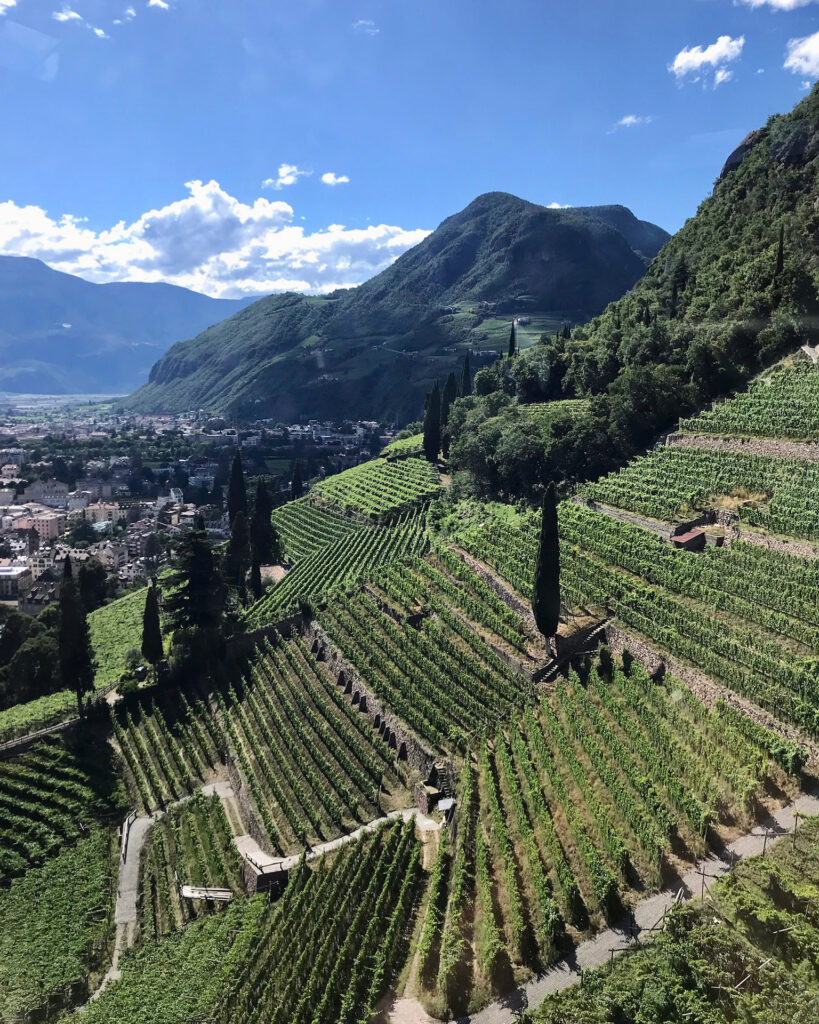
The Dolomites, a UNESCO World Heritage site located in northern Italy, are one of the most striking mountain ranges in Europe. Known for their dramatic peaks, lush meadows, and picturesque alpine villages, the Dolomites offer an unforgettable experience for outdoor enthusiasts and nature lovers. As sustainability becomes a more significant focus in tourism, the Dolomites are embracing green travel with eco-friendly initiatives, preserving their natural beauty, and providing visitors with a chance to experience nature responsibly.
This Green Travel Destination Guide to the Dolomites will highlight sustainable travel tips, green accommodations, eco-conscious activities, and ways to reduce your environmental impact while discovering one of Europe’s most breathtaking regions.
Getting to the Dolomites: Sustainable Travel Options
By Plane: The Dolomites are best accessed via Innsbruck Airport (Austria) or Venice Marco Polo Airport (Italy), both of which offer international flights. If you are flying, consider offsetting your carbon emissions through platforms like MyClimate or CO2logic, which allow you to neutralise the environmental impact of your flight.
By Train: For travellers already in Europe, taking the train to the Dolomites is a sustainable alternative to flying. Trains from cities like Venice or Verona offer scenic routes that bring you closer to the mountain range while reducing your carbon footprint. The nearest major train station is in Bolzano.
By Bus: From Venice or Verona, long-distance buses are available, offering a more sustainable way to reach the Dolomites. The bus rides are comfortable and provide an eco-friendly alternative to driving or flying.
Sustainable Transportation Within the Dolomites
While the Dolomites are famous for their spectacular landscapes, getting around in an eco-friendly manner is made easy by several sustainable transportation options.
Electric Buses: Several towns and villages in the Dolomites are connected by electric buses, making it easier to travel between areas with minimal environmental impact. These buses offer an eco-conscious way to navigate the region without contributing to air pollution.
Biking: The Dolomites are an ideal destination for cycling enthusiasts, with numerous bike paths and mountain biking trails that wind through the valleys and peaks. In summer, local operators offer e-bike rentals, allowing visitors to explore the region sustainably.
Walking: Hiking is one of the best ways to explore the Dolomites’ natural beauty, and the region has an extensive network of well-maintained hiking trails. Whether you’re trekking through alpine meadows or ascending mountain peaks, walking is a sustainable and immersive way to discover the Dolomites.
Car Sharing: If you’re traveling to more remote areas, car-sharing services such as GreenMobility and ShareNow offer electric and hybrid vehicles, allowing you to explore the Dolomites while minimising your carbon footprint.
Eco-Friendly Accommodations in the Dolomites
The Dolomites offer a range of accommodations that emphasise sustainability, from eco-conscious hotels to alpine lodges committed to minimising their environmental impact.
Hotel Lago di Braies: Located near the Lago di Braies, one of the Dolomites’ most beautiful lakes, this hotel is a pioneer in sustainable hospitality. The property uses energy-saving technologies, such as solar panels and low-energy lighting, and emphasises eco-friendly practices like water conservation and waste reduction.
Alpenpalace Luxury Hideaway & Spa Retreat: This eco-friendly luxury hotel in Ahrntal combines sustainability with indulgence. It uses renewable energy, practices water-saving measures, and sources local, organic produce for its gourmet restaurant. The property is also part of initiatives to protect the surrounding natural environment.
Genziana Hotel: A family-run hotel in Cortina d’Ampezzo, the Genziana Hotel is committed to sustainability by using eco-friendly materials, reducing energy consumption, and promoting environmental education for guests. The hotel also offers a wellness center that uses organic products.
Rifugio Auronzo: For those looking to experience the Dolomites more intimately, Rifugio Auronzo offers sustainable lodging at high altitudes. The mountain hut is powered by renewable energy and provides organic, locally sourced meals, creating a truly sustainable alpine escape.
Sustainable Attractions and Activities
The Dolomites are full of eco-friendly activities that let you connect with nature while supporting sustainable practices.
1. Hiking and Trekking
With over 1,000 kilometres of hiking trails, the Dolomites are a paradise for nature lovers. Popular trails include the Alta Via 1, which takes you through some of the most stunning mountain landscapes, and the Tre Cime di Lavaredo circuit, offering views of the iconic peaks.
Eco-tip: Stick to marked trails to protect the delicate alpine ecosystem, and always carry a reusable water bottle to minimise waste.
2. Via Ferrata Climbing
For adventurous travellers, Via Ferrata (iron routes) climbing offers an exciting way to scale the Dolomite peaks. These protected routes are well-maintained and are becoming a popular way to experience the mountains in a responsible and eco-friendly way.
Eco-tip: Use eco-friendly climbing gear, such as harnesses and ropes made from sustainable materials, and avoid littering in the mountains.
3. The Dolomites UNESCO World Heritage Site
The Dolomites’ status as a UNESCO World Heritage Site makes them a must-see for those interested in preserving cultural and natural heritage. The UNESCO designation emphasises the need to protect the unique geology and biodiversity of the region.
Eco-tip: Join an eco-tour to learn about the geological and ecological significance of the Dolomites while supporting responsible tourism efforts.
4. Skiing and Snowboarding (Winter Eco-Tourism)
In winter, the Dolomites transform into a skiing and snowboarding haven. Sustainable ski resorts in the region, like Alta Badia and Val Gardena, have made significant strides in implementing eco-friendly practices, such as energy-efficient lift systems, waste reduction programs, and sustainable snow production.
Eco-tip: Choose ski resorts that prioritise renewable energy, minimise water and energy consumption, and support environmental conservation programs.
5. Lago di Braies
One of the most iconic lakes in the Dolomites, Lago di Braies offers crystal-clear waters surrounded by towering peaks. It’s a popular spot for kayaking, hiking, and photography. The area also has a focus on sustainable tourism, with efforts to preserve the lake’s pristine environment.
Eco-tip: Respect the natural beauty of the lake by not disturbing wildlife and by following Leave No Trace principles.
Eco-Friendly Dining and Shopping
The Dolomites offer a range of dining experiences that emphasise local, organic, and sustainable ingredients, as well as eco-conscious shopping opportunities.
1. Local Farmers’ Markets
Visiting the local farmers’ markets in Bolzano, Cortina d’Ampezzo, or other villages in the Dolomites is a great way to support local farmers and reduce your environmental footprint. These markets sell fresh, seasonal produce and handmade products that are grown and crafted locally, minimising food miles.
2. Ristorante La Stua de Michil
Located in Cortina d’Ampezzo, La Stua de Michil is a Michelin-starred restaurant that emphasises local, organic ingredients. The restaurant works closely with local farmers and artisans to source the best produce, meats, and cheeses, all while adhering to sustainable practices.
3. Eco-Friendly Souvenirs
When shopping for souvenirs, opt for items made from locally sourced materials or sustainable production methods. Artisans in the Dolomites create handmade products, such as woollen clothing, leather goods, and wooden crafts, all with a focus on sustainability.
Green Travel Tips for the Dolomites
- Offset Your Carbon Emissions: Use carbon offset programs to neutralize the environmental impact of your flight or transportation to the Dolomites.
- Pack Light: When hiking or skiing, try to pack light to reduce the environmental impact of your trip. Consider using eco-friendly, reusable gear for activities.
- Choose Eco-Friendly Operators: Opt for tour operators and activity providers who prioritize sustainability, such as offering small-group tours, carbon-neutral operations, and environmental education.
- Respect Local Ecosystems: Always follow local guidelines when hiking, biking, or skiing to protect the fragile alpine environment.
The Dolomites as a Green Destination
The Dolomites offer a truly sustainable travel experience, where visitors can enjoy breathtaking landscapes while supporting eco-conscious initiatives. With their extensive network of eco-friendly activities, green accommodations, and commitment to environmental preservation, the Dolomites are the perfect destination for travellers seeking both adventure and sustainability. Whether hiking in the summer, skiing in the winter, or exploring the region’s charming villages, the Dolomites provide countless ways to experience nature responsibly. By making green choices throughout your trip, you’ll not only preserve the beauty of the Dolomites but also help ensure that this incredible region remains a sustainable destination.

E: Egadi Islands, Italy
Green Travel Guide to Egadi Islands
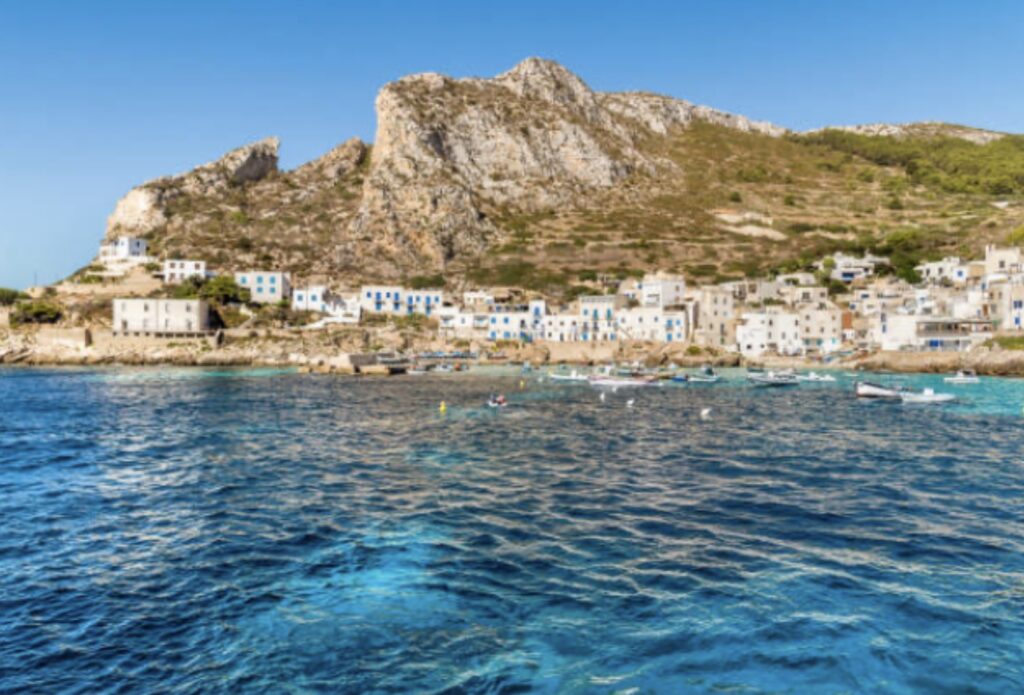
Located off the western coast of Sicily, the Egadi Islands are a stunning and lesser-known destination for travellers looking to explore Italy’s natural beauty while minimising their environmental impact.
Comprising Favignana, Levanzo, and Marettimo, these islands are part of the Egadi Islands Marine Protected Area, one of the largest marine reserves in Europe. With crystal-clear waters, rugged coastlines, charming fishing villages, and a rich history, the Egadi Islands offer a perfect destination for eco-conscious travellers seeking to experience authentic island life in a sustainable way.
This Green Travel Destination Guide to the Egadi Islands highlights eco-friendly accommodations, sustainable activities, green transportation, and tips on how to enjoy this beautiful archipelago responsibly.
Getting to the Egadi Islands: Sustainable Travel Options
By Plane: The nearest airport to the Egadi Islands is Trapani-Birgi Airport (TPS), which is about 20 kilometres from the port where ferries depart to the islands. Several budget airlines serve this airport, making it easy to reach the region. If you’re flying, consider carbon-offsetting your flight emissions through programs like MyClimate or CO2logic.
By Ferry: The greenest way to reach the Egadi Islands is by taking a ferry. Ferries depart regularly from Trapani to the islands, with options for both high-speed boats and traditional ferries. The ferry ride offers stunning views of the Mediterranean and is an eco-friendly way to travel. You can use companies like Liberty Lines or Siremar that operate environmentally conscious fleets.
By Train: If you’re traveling from within Italy, trains are a sustainable way to reach Trapani. Italy’s train system is well-connected and offers a relatively low-carbon alternative to flying.
Sustainable Transportation on the Egadi Islands
The Egadi Islands are perfect for eco-friendly travel, with options for getting around that allow visitors to explore in harmony with the environment.
Walking and Hiking: Walking is the best way to explore the Egadi Islands. The islands offer beautiful walking trails, including routes that wind through olive groves, up to scenic viewpoints, and along the coastline. This not only reduces your environmental footprint but also allows you to experience the islands’ natural beauty up close.
Biking: Renting a bike is another sustainable way to navigate the Egadi Islands. All three islands—Favignana, Levanzo, and Marettimo—have bike rentals available, and many roads are relatively flat and easy to cycle. Biking allows for a more immersive experience and is perfect for getting around at your own pace.
Electric Scooters and Cars: For travellers who prefer faster transportation, electric scooters or electric cars are available for rent on the islands. These eco-friendly options help reduce your carbon emissions compared to conventional vehicles.
Boat Rentals: To explore the islands’ surrounding waters, consider renting electric boats or smaller, eco-friendly vessels. There are options for renting boats with lower emissions to navigate the pristine waters around the Egadi Islands without disturbing the marine ecosystem.
Eco-Friendly Accommodations in Egadi Islands
For travellers looking to stay in a sustainable and environmentally conscious way, the Egadi Islands offer several green accommodations that focus on eco-friendly practices.
Hotel Tempo di Mare: Located in Favignana, this eco-hotel is committed to sustainability by using renewable energy, water-saving technologies, and waste reduction practices. It also features an organic garden and supports local agriculture by sourcing fresh, local produce for its restaurant.
Case Vacanza Marettimo: For a more intimate, self-catering experience, Case Vacanza Marettimo offers eco-friendly apartments on the island of Marettimo. The property focuses on using local materials in its construction, provides solar-powered energy, and encourages guests to follow sustainable practices.
Eco Lodge Favignana: A charming and eco-conscious lodge located in Favignana, the Eco Lodge uses solar panels, energy-efficient lighting, and promotes water conservation. The property is surrounded by lush greenery, offering a tranquil and sustainable retreat.
B&B La Casa del Capitano: On Levanzo, this bed and breakfast provides a sustainable stay with a focus on eco-tourism. The property uses locally sourced, organic food and ensures waste is minimised through recycling and composting. Its small-scale, intimate nature makes it a great eco-friendly option.
Sustainable Activities and Attractions
The Egadi Islands are a paradise for nature lovers and outdoor enthusiasts. Visitors can engage in various eco-conscious activities that allow them to connect with the islands’ natural beauty while preserving their environmental integrity.
1. Snorkeling and Scuba Diving in the Marine Reserve
The Egadi Islands Marine Protected Area is one of the largest marine reserves in Europe and is home to diverse marine life, including sea turtles, dolphins, and vibrant coral reefs. Sustainable snorkeling and scuba diving tours are available, where you can explore the underwater world while adhering to eco-friendly practices that minimise environmental disturbance.
Eco-tip: Choose operators who follow sustainable diving practices, such as respecting marine life, using biodegradable products, and maintaining a low-impact approach.
2. Hiking Trails on Favignana and Marettimo
The Egadi Islands offer a variety of hiking trails that take you through beautiful landscapes, from Favignana’s rugged cliffs to the mountains of Marettimo. These trails often offer panoramic views of the sea, olive groves, and the islands’ unique flora and fauna. Hikes are well-marked and range from easy walks to more challenging routes.
Eco-tip: Stick to marked trails and respect nature by not disturbing wildlife or leaving trash behind. Bring your own reusable water bottle to minimise waste.
3. Visiting the Tonnara di Favignana
The Tonnara di Favignana is a historic tuna fishery that once played a key role in the island’s economy. Today, it serves as an educational site that promotes sustainable fishing practices and the region’s historical fishing culture. Visitors can learn about traditional tuna fishing and its environmental implications.
Eco-tip: Support sustainable seafood by choosing restaurants that serve locally sourced, responsibly harvested fish and seafood.
4. Kayaking Around the Islands
Exploring the coastline by kayak is an eco-friendly way to experience the beauty of the Egadi Islands. Paddle through hidden coves, crystal-clear waters, and limestone caves while avoiding the carbon footprint associated with larger boat tours.
Eco-tip: Choose kayak rentals from companies that focus on eco-conscious tourism and avoid using motorised boats that pollute the environment.
5. Visiting Levanzo’s Caves and Archaeological Sites
The island of Levanzo is known for its prehistoric caves, particularly the Cave of the Genovese, which contains ancient rock art. Visiting these archaeological sites is a great way to connect with the island’s history while supporting sustainable tourism that helps protect these sites.
Eco-tip: Visit sites with a certified guide who emphasises sustainable practices and historical preservation. Avoid touching or disturbing rock art and other archaeological features.
Eco-Friendly Dining and Shopping
The Egadi Islands are home to several restaurants and markets that promote sustainable, local, and organic dining options.
1. Trattoria del Porto (Favignana)
This eco-conscious restaurant specialises in locally caught fish and sustainable seafood. They focus on using organic, seasonal ingredients in their dishes and work with local farmers and fishermen to support the island’s economy and reduce food miles.
2. La Dolce Vita (Levanzo)
A family-owned restaurant on Levanzo, La Dolce Vita focuses on organic food and sustainable dining. They serve locally sourced ingredients and minimise their carbon footprint by using energy-efficient kitchen equipment.
3. Local Farmers’ Markets
The islands feature several farmers’ markets where you can purchase locally grown produce, handmade goods, and artisanal products. Supporting local markets helps reduce the environmental impact of food transport and encourages sustainable agriculture.
4. Souvenir Shopping at Eco-Shops
Look for shops that sell handcrafted products made from locally sourced materials, such as handmade pottery, woven baskets, and natural cosmetics. Supporting local artisans reduces the need for mass-produced goods and helps preserve the island’s cultural heritage.
Green Travel Tips for the Egadi Islands
- Offset Your Carbon Emissions: Consider offsetting your carbon emissions if you’re flying to the Egadi Islands through programs that invest in renewable energy or forest conservation projects.
- Use Reusable Items: Bring your own reusable water bottle, shopping bags, and containers to avoid single-use plastic waste on the islands.
- Choose Eco-Friendly Operators: Book tours and activities with companies that promote sustainable practices and respect local ecosystems.
- Respect Nature: Whether you’re hiking, biking, or swimming, always follow the Leave No Trace principles, ensuring the islands’ natural beauty is preserved for future generations.
The Egadi Islands as a Green Destination
The Egadi Islands offer a rare opportunity to experience an authentic, sustainable island getaway. With a focus on preserving natural landscapes, supporting local communities, and reducing environmental impact, these islands are an ideal destination for eco-conscious travellers. Whether you’re exploring on foot, by bike, or kayaking along the coastline, the Egadi Islands provide a peaceful retreat that encourages responsible tourism and offers a real connection to nature. By making mindful choices throughout your visit, you can help protect the beauty and biodiversity of this stunning archipelago.
